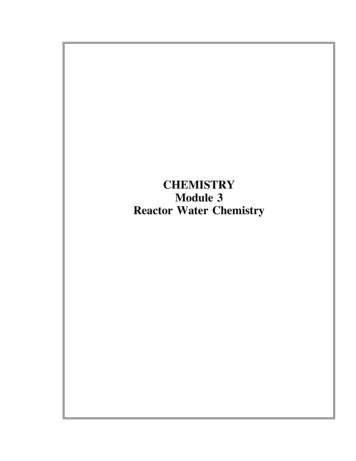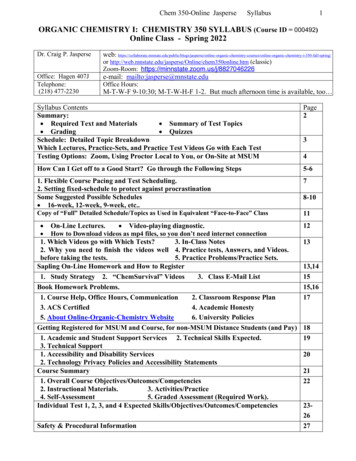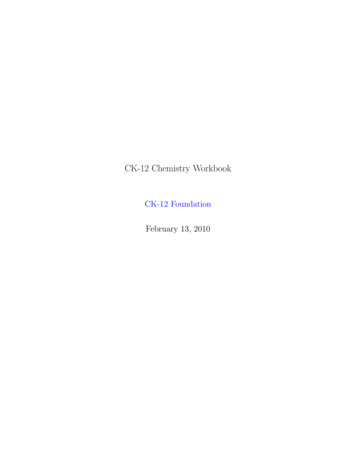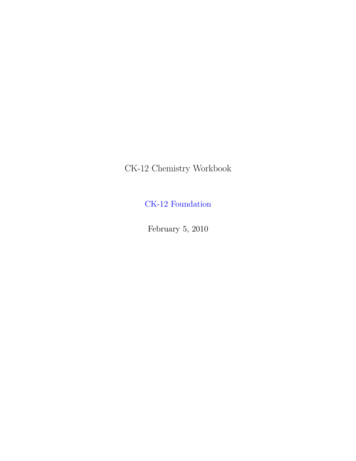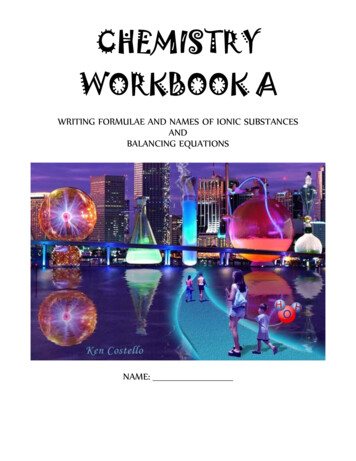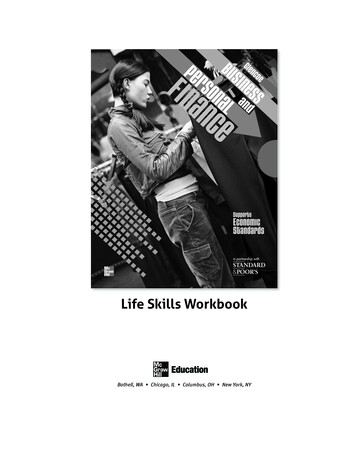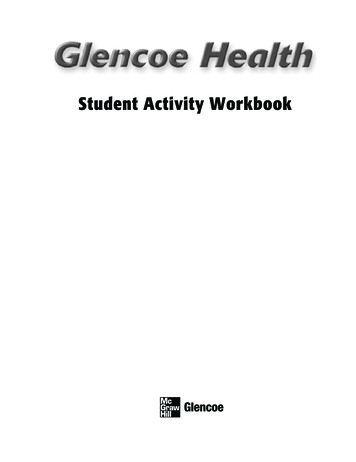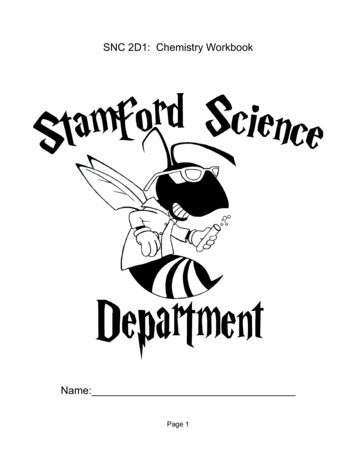
Transcription
SNC 2D1: Chemistry WorkbookName:Page 1
www.stamfordscience.orgTable of Contents Introduction Learning Goals Vocabulary Checklist Assessment Check List “Big Idea” Chemistry Project Module 1 – physical and chemical properties, pure substances and mixtures, atomicstructure (Bohr-Rutherford model), valence electrons and ionic charges Module 2 – periodic table, ionic charges within families, bonding (ionic, polyatomic,molecular) Module 3 – chemical reactions, conservation of matter, balancing equations, types ofchemical reactions, acids & bases ReviewPage 2
Grade 10 Academic Science (SNC 2D1)Introduction to ChemistryWelcome to Chemistry!As we move forward through the chemistry unit, we will review concepts you covered ingrade 9, such as physical and chemical properties, pure substances, mixtures and chemicalchanges.We will also touch on new topics such as: why chemicals react, characteristics of chemicalreactions and how these reactions can be represented. We will also analyze various safetyand environmental issues related to chemical reactions and how chemical reactions can beused to address environmental challenges.Ensure that you take the time to learn the material, do the practice work, ask for help soonerrather than later and use the assessment checklist to ensure that all items that allassessments of your learning are completed and submitted.Good Luck!Page 3
Grade 10 Academic Chemistry Student Learning Goals/ChecklistBy the end of this strand, I will be able to: use appropriate terminology related to chemistry (see vocabulary checklist). describe the relationships between chemical formulae, composition and names of binarycompounds. identify simple ionic compounds, polyatomic compounds, molecular compounds and acidsusing the periodic table and a list of common polyatomic ions and write the formulae. classify physical and chemical changes. describe the types of evidence that indicate chemical change. describe, on the basis of observation, the reactants in and the products of a variety of chemicalreactions. investigate the law of conservation of mass in chemical reactions and account for anydiscrepancies. explain, using the law of conservation of mass and atomic theory, the rationale for balancingchemical equations. write word equations and balanced chemical equations for simple chemical reactions. construct molecular models to illustrate the structure of molecules in simple chemical reactionsand produce diagrams of these models. investigate simple chemical reactions, including synthesis, decomposition, and displacementreactions and represent them using word equations and balanced chemical equations. describe how the pH scale is used to classify solutions as acidic, basic or neutral plan and conduct an inquiry to classify some common substances as acidic, basic or neutral. describe the process of acid-base neutralization. analyse, on the basis of research, various safety and environmental issues associated withchemical reactions and their reactants and products. analyse how an understanding of the properties of chemical substances and their reactionscan be applied to solve environmental challenges.Page 4
Grade 10 Academic Chemistry Vocabulary ChecklistBy the end of this strand, these words/phrases should be familiar to you. Review your notesor stamfordscience.org for definitions. atombalanced chemical equationchemical changechemical equationcoefficientcompounddiatomic moleculeelectronelementionionic compoundlaw of conservation of massmattermetalmolecular compoundmoleculemultivalent elementnon-metalpolyatomic ionproductreactantshellskeleton equationstateword equation acidacid leachingacid precipitationacid-base indicatorbaseneutralneutralizationpH scaleprecipitateuniversal indicator combustiondecomposition reactiondouble displacement reactionfossil fuelhydrocarbonsingle displacement reactionsynthesis reactionPage 5
Assessment ChecklistThroughout this course, we will use various assessment methods to provide “formativeassessment”. That is, assessment FOR and AS learning. These are used to provide feedbackand self reflection to improve your learning and understanding.However, some items are used as an assessment OF your learning. These are listed in thechart below. You should keep track of these items and ensure that all of them are completedand submitted on time according to the class expectations (see first day handout).ItemKeep inWorkbookor Hand-inTotalMarksHousehold SubstancesBook5Density WorksheetsBook4Bohr Diagrams and Ionic ChargesBook4Overall completion of Module 1Book4Hand-in10Book6Nomenclature QuizHand-in11Lab: Testing IonsHand-In10Bonding Gizmo (Ionic or Covalent)Hand-In8Overall completion of Module 2Book4Lab: Conservation of MassHand-In8Lab: Synthesis and Decomposition RxHand-In8Lab: Single and Double Displacement RxHand-In8PH GizmoHand-In8Lab: Acids and BasesHand-In8Book4Hand-InTBD------TBDAlien Periodic TableIonic Charges and Chemical FamiliesOverall completion of Module 3Big Idea Chemistry ProjectUnit TestPage 6DueDateYourMark
“Big Idea” Chemistry ProjectUsing one of the topics listed below, you must address the following points: What is the concern/issue/problem?How has chemistry/science contributed to this issue?How have other factors have contributed to this issue?What are the long term environmental impacts?What are some possible solutions?How can chemistry/science help with these solutions?The format for this report can be: a website www.weebly.com or www.wikispaces.coma cartoon interview with a scientist www.xtranormal.coma presimodo presentation www.presimodo.coma power-point presentationa double spaced typed written report (2-3 pages)a “bristol-board” presentationYou may use one of the topics from the list. If you wish to do a different topic, you must getprior approval early in the unit. Acid Precipitation Ocean Acidification Keystone Pipeline and/or Northern Gateway Pipeline Controversy Oil spills in water ways (oceans, seas, etc).think ocean tankers or offshore drilling Nanotechnology Smokestack emissionsA list of cited resources must also be included!!Page 7
SNC 2D1 – Gr. 10 Academic ScienceModule 1– Physical and Chemical Properties– Pure Substances and Mixtures– Atomic Structure (Bohr-Rutherford model)– Valence Electrons and Ionic ChargesPage 8
Page 9
Physical Properties Reference TableComplete definitions/explanations for these physical properties from grade eabilityductilityviscositysolubilitydensitymelting pointboiling pointfreezing pointPage 10
Page 11
Page 12
Layer the following substances in the beaker below, based upon their given densities.Substance 4.20Page 13
Page 14
Page 15
Page 16
Page 17
Page 18
Page 19
SNC 2D1 – Gr. 10 Academic ScienceModule 2– Periodic Table– Ionic Charges Within Families– Bonding (ionic, polyatomic, molecular)Page 20
Page 21
Periodic TableComplete the following chart, using your periodic table.Element NameSymbol AtomicNumberGroupNumberPeriodNumber175Metal dargon202Alkali metal7Page 22
Page 23
Page 24
Page 25
Naming Simple Binary CompoundsComplete the following chart by writing either the name or the formula as required.CaCl2Strontium SulfidePotassium IodideMgOCalcium PhosphideAlCI3Aluminum ChlorideNaBrCalcium IodideRb3PAl2O3Barium OxideLithium NitrideBarium PhosphideCaORadium NitrideBarium ChlorideSodium ChlorideZinc PhosphideAg2OZnOSilver IodideSilver BromideLanthanum ChloridePotassium ChloridePotassium PhosphideCalcium ChlorideMagnesium NitrideSodium SulfideLiP3Barium FluorideRubidium OxideCalcium NitrideBeryllium NitrideCaOYttrium OxideLi2OIndium FluorideNaBrAcPMgOCs2SZnONa3PKFAluminum OxideStrontium ChlorideMagnesium SulfideZinc SulfideK2SFrBrSodium IodidePage 26
Naming Complex Binary Compounds (Multiple Valencies)Complete the following chart by writing either the name or the formula as required. Some of the metals MAYhave multiple valencies that need to be specified using the brackets in the name.be observant!!Magnesium OxidePbSLi2OSodium FluorideAlCl3Aluminum NitrideMgSLithium IodideCalcium OxideSnO2Beryllium OxideNa2SNickel(II) ChlorideMg3P2CaOMagnesium NitrideAluminum SulfideNiOCopper(I) BromideCuIKBrTin(II) IodideBeFIron(III) ChlorideCalcium PhosphidePbCl4Lead(II) OxideFePLead(IV) FluorideCaF2Na3NTin(IV) BromideAl2O3Copper(II) SulfideCuCl2Iron(II) OxideCalcium NitrideFeBr3K3PAgFPage 27
Naming Polyatomic CompoundsComplete the following chart by writing either the name or the formula as required. Be careful.there is a mixtureof both multiple and single valence metals.Sodium ChloratePb3(PO4)2Li2CO3Aluminum NitrateK2SO4Potassium HydroxideLithium PhosphateSn(ClO3)2Calcium CarbonateNaOHCa(NO3)2Beryllium SulfateMg3(PO4)2Sodium BicarbonateAl(HCO3)3Magnesium HydroxideAluminum PhosphateCuNO3Copper(I) ChlorateFeSO4NaNO3Calcium SulfateAl(OH)3Lead(II) NitrateCuSO4Copper(II) HydroxideIron(II) PhosphateCa(HCO3)2Calcium ChlorateK3PO4FeClO3Magnesium SulfateCopper(I) SulphateLithium PhosphatePotassium HydroxideUranium(III) CarbonateMercury(I) BromidePotassium PermanganateAg2SO4Aluminum PhosphateZn(OH)2BaSO4CuSO4Bi(OH)3Page 28
Naming Molecular/Covalent CompoundsComplete the following chart by writing either the name or the formula as required. Since this ismolecular/covalent bonding remember to use the Greek prefixes as required.CF4Ammonia (Nitrogen Trihydride)Carbon DioxideCarbon MonoxideHydrogen Peroxide (Dihydrogen Dioxide)H2ONF3P2O3P2O5PCl3Cl2O5Carbon DisulfideCCl4Methane (Carbon Tetrahydride)SiO2BCl3Page 29
SNC 2D1 – Gr. 10 Academic ScienceModule 3– Chemical Reactions– Conservation of Matter– Balancing Equations– Types of Chemical Reactions– Acids & BasesPage 30
Page 31
Writing Chemical Equations1. What is the advantage of writing a chemical equation?2. For the chemical equation propane oxygena) the reactantscarbon dioxide water , state:b) the products:c) the purpose of the arrow3. Write a word equation for the following reactions:a) CaCl2 and Na2SO4 react to form CaSO4 and NaClb) AgNO3 reacts with KCl to produce AgCl and KNO3c) In the process of cellular respiration, carbon dioxide, water and energy are producedwhen sugar is reacted with oxygen by the cell.Reflect on the following word equations and predict what elements or compounds belong inthe blank space.a) Aluminum resists corrosion because it reacts with a gas in the air to form a protecticecoating. The equation is:aluminum aluminum oxideb) When aluminum foil is place in a solution of copper(II) sulfate, the aluminum will displacecopper from the solution and take its place:aluminum copper(II) sulfatecopper c) When solutions of potassium iodide and lead(II) nitrate are mixed, lead(II) iodide willprecipitate out leaving the other compound in solution:potassium iodide lead(II) nitratePage 32lead(II) iodide
Page 33
Page 34
Page 35
Types of Chemical ReactionsBalance the following reactions and indicate which of the five types of chemical reaction arebeing represented:1) NaBr Ca(OH)2CaBr2 NaOHType of reaction:2) NH3 H2SO4(NH4)2SO4Type of reaction:3) C5H9O O2CO2 H2O ***challengingType of reaction:4) Pb H3PO4H2 Pb3(PO4)2Type of reaction:5) Li3N NH4NO3LiNO3 (NH4)3NType of reaction:6) HBr Al(OH)3H2O AlBr3Type of reaction:Page 36
SNC 2D1 CHEMISTRY STRAND REVIEW1. For each of the following, suggest one or more situations in which chemical reactionsare important.(a) in your home(b) at tourist resorts(c) in restaurants in your community(d) in another situation of your choice2. Pure substances are used to produce newspapers, paper towels, clothing, and manyconsumer products you use daily. What happens to these pure substances when youno longer need these products? Suggest several answers.3. Every Canadian province has emergency teams and procedures to deal with chemicalspill situations. Why do you think it is important to have laws that cover an entireprovince?4. Suppose a train derailment spills sodium hydroxide into some soil. Use yourknowledge of chemical reactions to suggest how an emergency response team couldneutralize the effects of this chemical.5. Write the symbols for the following ions.(a) cesium (b) oxide(c) nickel(III)(d) tin(II)6. Write the name of the following ions.(a) Mg 2(b) Ag 1(c) F –1(e) titanium(IV)(d) N - 3(e) Au 17. (a) What kind of electric charge do metallic ions possess?(b) What kind of electric charge do nonmetallic ions possess?8. What elements make up “the group of 7”. What is special about them?9. What is the difference between a molecule that is an element and a molecule that is acompound?10. How many occupied shells are there in a neon atom?11. What kinds of elements combine to form ionic compounds?12. What kinds of elements combine to form molecular compounds?13. State the law of conservation of mass.14. Where are the reactants and the products located in a chemical equation?15. What is the typical range of numbers on the pH scale? What is the pH range of basesWhat is the pH range of acids?Page 37
16. What kinds of substances are the reactants in a neutralization reaction?17. How can you identify an acid and a base from their chemical formulas?18. What type of chemical reaction is represented by these general chemical equations?(a) A B AB(b) CxHy O2 CO2 H2O19. Complete and balance each equation below. The products are all solid ioniccompounds.(a) Na Br2 (b) Mg F2 (c) Al Cl2 20. Suppose the
SNC 2D1: Chemistry Workbook Name:_ Page 1. www.stamfordscience.org Table of Contents Introduction Learning Goals Vocabulary Checklist Assessment Check List “Big Idea” Chemistry Project Module 1 – physical and chemical properties, pure substances and mixtures, atomic structure (Bohr-Rutherford model), valence electrons and ionic charges Module 2 .

